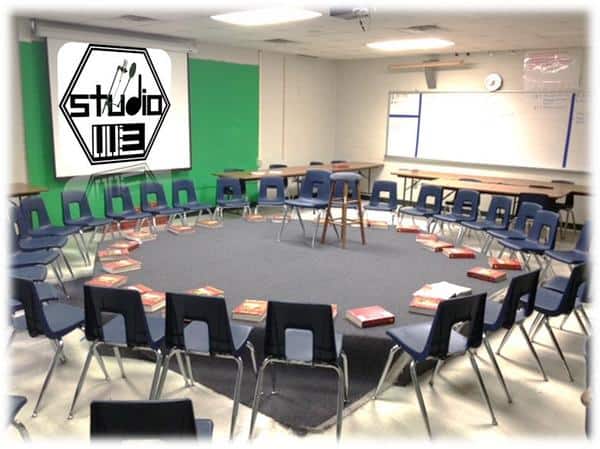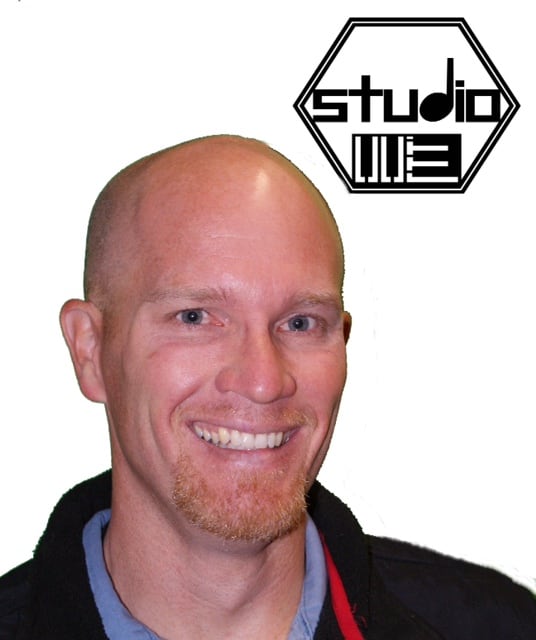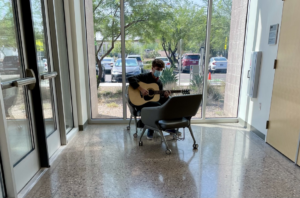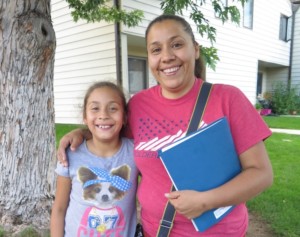Classroom Design and the Learning Experience

Okay. Bear with me a moment as I review my summer checklist.
Let’s see…Have I self-assessed and asked myself challenging, end-of-the-school-year questions? Check. Have I taken a family vacation and re-established my priorities? Check. Have I attended an inspirational conference? Check. Have I led two days of professional learning and shared my best and worst classroom practices? Check. Have I connected with a multitude of educators and continued my self-prescribed professional learning on a weekly basis by following passionate teachers on Twitter? Check. Have I continued to write as a form of collegial sharing and self-reflection? Check.
Before I move into a new classroom, have I re-evaluated my classroom design and given serious contemplation to the learning experiences it perpetuates? Hmmm. Well, that time is now.
And here is my plan.
A Centered Stage
Since 2007, one thing has been unquestionable about our classroom. A stage in Studio 113, an interactive language arts learning environment at East Hall High School, is a mainstay. This essential, centered piece is the backbone of our approach to writing creatively and to studying literature. For the last seven years, I have been blessed to teach in a classroom that builds activities, and even the setting of the entire classroom, around a stage. Last year’s teaching experience at EPiCC Academy was very similar due to the luxury of a portable and adjustable stage in a larger, shared classroom.
Our hexagonal stage, which served as the impetus for our class logo, was accidentally discarded this summer by a construction crew as our school underwent major renovation. No worries, however. The principles, purposes, and power of a centered stage to create a dynamic classroom and unique, memorable learning experiences is alive and well in a new, rectangular stage. Let’s take a look at this power.
A P.E. Class-When things are going very well in Studio 113, many students refer to our learning environment as a “P.E.” class. However, the “P.E.” stands for “Physical English.” You see, we like to bring literature, poetry, and writing to life. What’s our secret? Nothing major. We simply “embrace the stage” and make words visible by performing original improvisational and planned skits from Whose Line Is It Anyway?
Interactive Learning Structures-Based primarily on the functionality of our centered stage, Studio 113 participants have been creating interactive learning structures that engage students in creative, collaborative, and energizing class activities since 2007. Whereas some activities encourage improvisational acting and respectful debates, others are gamified by using strategies to randomly select students and teams to perform tasks that relate directly to the assigned standards. Believe me, judging from the students’ responses during classes and my colleagues’ enthusiasm during workshops at educational conferences, these stage-based activities are a hit. Seriously. Check out the following titles of just some of our forty-plus structures and see if they sound interesting: “Random Chaos,” “Voting Chips,” “Revolutionary Battle,” “The Chosen Ones,” “Literary Revolver,” “Stage Fright,” “Flip Forum, Silent Discussion, & Unaware Speaker,” “Concentric Circles,” “Firing Squad,” “Force Field,” “Surround Sound Debate Structure,” “The Web,” “The Perimeter, the Players, & the Offering,” and “The Wax Museum.” The replacement of our six-sided, stationary stage with an 8’ x 12’ x 1’ flexible, mobile stage that consists of three separate parts will spur all of us in Studio 113 to create even more rocking learning structures. I mean, just imagine what different designs and structures can be created by reconfiguring three 4’ x 8’ x 1’ individual stage pieces and merging them with solid lesson plans.
The #1 Fear-I love this quotation form Mark Twain: “There are two types of public speakers: those that are nervous and those that are liars.” I believe it to be true. Do you? And according to this article, “public speaking is the number one fear in America.” No problem, though. I say this fear should be brought to light on the stage through the 3 A’s of awareness, acceptance, and action. By collectively admitting that all students experience this nervousness on various levels, the class participants are able to quickly move through acceptance and into action. And that’s where the beauty of the stage shines. Through culminating presentations as a result of rigorous project/passion/problem-based learning assignments, students in Studio 113 are encouraged to strengthen their speaking skills…on stage…in front of their peers…and in front of the camera. I’ve seen it year after year…students speak to me of their initial speaking fears and how grateful they are for the support of the stage. The strength in their eyes, as they articulate their journey with such appreciation, is all the evidence I need.
The Seating Arrangement
Students in Studio 113 usually sit in individual chairs at circular tables. Just like the stage, these chairs and tables offer flexibility. With the cooperation of the entire class, the stage and all tables, which possess a dry-erase surface, can be folded and placed along the walls, while the chairs can be quickly stacked to reveal an open-floor class. This quickly created, vacant area can serve a number of purposes. Although the above diagram illustrates seating arrangements predicated on a number and letter system used for certain interactive learning structures, Studio 113 is totally flexible. In fact, many observers come to visit only to find tables and chairs replaced by lawn chairs, bean bags, and blow-up sofas that were brought by the students. Changes in the classroom layout are dictated by what learning experiences are needed, and requested, by the students.
The Music Studio
Besides the stage, one other aspect of Studio 113 that students never want to be without is a music studio. Whether it is something relatively simple like ours (a couple of microphones, a small channel mixer, a stage snake, and Acoustica Mixcraft software on a designated desktop computer) or a bit more complex like EPiCC Academy’s, connecting music with literature, writing, and the standards is a must. Click here to witness some of our original tracks from the past.
A Teacher’s Desk Rolling Cart
Heck, I gave up a large teacher’s desk back in 2000, and I haven’t looked back ever since. To promote technical efficiency, classroom mobility and spatial minimalism, my “desk” is a media cart on wheels. Just take a look at what all is stored in this small, concise space. Wondering about any paper assignments that are turned in by the students? Hanging wall folders take care of those, and Google Drive and Canvas take care of the rest.
The “Everywhere” Classroom and BYOD
Studio 113 isn’t confined to four cement walls. No, sir. In fact, our students’ learning experiences transcend traditional classroom settings on a weekly basis. Whether it’s using an exciting new learning management system and its mobile app, participating in a four-class/three-state tweetup, using smartphones to view the world as one large homework assignment, or by leveraging the power of any technology gadget in class as a part of a BYOD policy, Studio 113 offers learning “experiences.”
And I can’t wait to witness what awesome “experiences” this year’s Studio 113 classes will create.









Quim
Good job John. Very interesting article. Congratulations!
Lisa Sheehy
Thank you for being a teacher on the stage - you've helped me be a braver and better teacher! It's going to be an amazing year.
John Hardison
Thanks, Quim. I'm a big fan of EdPuzzle. Keep up the great work.